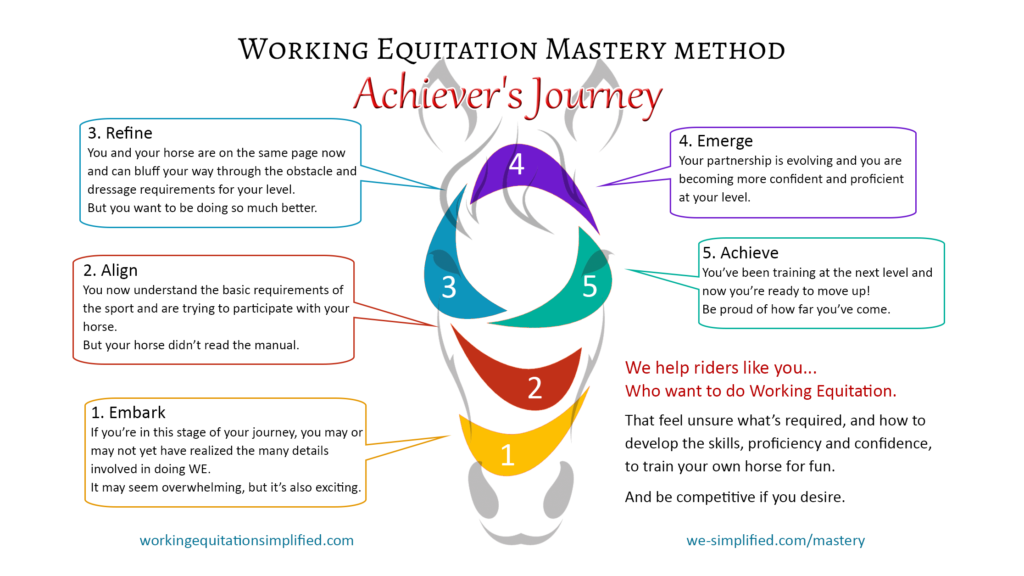As a trainer,...and yes you are.
If you're interacting with a horse you're training them to do the right thing, or the wrong thing.
You may be embarking on your journey of Working Equitation.
Or you may be at the Align level,
You now understand the basic requirements of the sport and are trying to participate with your horse.
But your horse didn’t read the manual.
Some of you are starting to also Refine.
You and your horse are on the same page now and can bluff your way through the obstacle and dressage requirements for your level.
But you want to be doing so much better.
As a trainer it's your job to prepare your horse, and then test your horse to see if you prepared them well enough.
But also to become tuned in to where you read their mind (or body) and know when to exit (the thing you've asked them to do) before things fall apart.
It takes time to learn this skill. And there will always be mistakes.
But you learn it by taking things one step at a time so you have time to evaluate whether the next step will be correct, or need a correction.
And yes, you learn it by making mistakes, and realizing you’ve made them so you can learn from them.
Try not to let the fact that you're in a course, a lesson, a clinic and yes, even a horse show, determine how you ride.
But instead make the horse and their comfort always your priority.
The best riders! They're not out there to just show you they can do the requirements of their discipline or level. Or even how well they can do the requirements of their discipline.
They are showing you the best their horse can do in that moment, in those circumstances, and not asking for more than what they think they can get.
That's a horseman or horsewoman.
And when you're horse knows that their comfort is your priority. That you've got their back. And that you won't ask them for things they can not do.
Then sometimes you can ask for that little bit more and they will try, and if they can't do it that day, they will forgive your error.
I include a variety of skills and tasks in my lessons and courses, but I don't say “we're all going to learn how to do X”
Because maybe your horse isn’t ready to do X.
My most recent course sales page and instructions said, “Your choice of 1-5 obstacles”.
Not we will teach our horse to do 5 obstacles.
Why a choice? Because what we can do is dependent on how your horse reacts.
I know people like to have a goal.
And they like to 'complete' things.
And a goal can be useful.
The WE Mastery program has a goal of taking you from new to Working Equitation to being comfortable at your first show or clinic. or if already there, to your next level.
But a goal has to be broken down into sub-goals, and tasks, and sub-tasks and the accomplishment of even the tiniest one of those has to be just as worthy of reward as completing the main goal.
Reward for your horse, certainly.
But also reward for your sense of accomplishment.
When you are satisfied that you have completed the tiniest sub-task to the best of your current ability. Be proud. Be happy. And be thankful.
One day all these sub-tasks, will become tasks, that come together to complete sub-goals and ultimately help you achieve your main goal.
But if any one of those sub, or even sub-sub-tasks is ignored. The main goal will never be achieved.
That is so important it bears repeating.
If any ONE of those sub, or even sub-sub-tasks is ignored, the big goal will never be achieved.
Just like horse training, the Working Equitation Mastery Achiever's Journey is not linear.
Parts of it are, as in the step-by-step lesson, but, you always have to revisit and revise the sub-tasks.
You need to be noticing every step, and how your horse is feeling in that moment.
Nothing else matters.
Not my course, not my goals, and not your goals.
How is your horse feeling, and what can you do to improve that?
That's why Working Equitation is such a great sport for developing the horse.
When you have achieved your goals of a certain score at a certain level, you start again.
Perfecting the foundation (Refine).
And how your horse feels about and during every step as they work towards your next big goal (Emerge).
Until you’re ready to test that you’ve reached your goal (Achieve).
And then circle back and start again refining, but always listening to your horse because how they feel is the only thing that matters.
That’s the 1 goal.
The thing that must always be in the front of your mind as you work towards other goals.
How they feel is the only thing that matters!
Registration is now open for the Working Equitation Mastery program.
You CAN learn how to improve your horse's skills from online courses and tips such as these.
But only if you implement.
So when you read my articles write down the steps or thoughts that come to mind as a reminder for what you're going to try in your next ride.
Come on back when you're done and let me know how it went.

